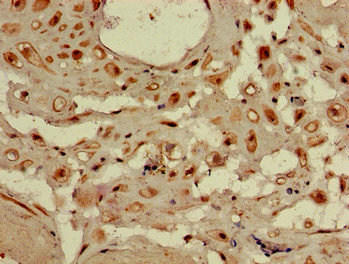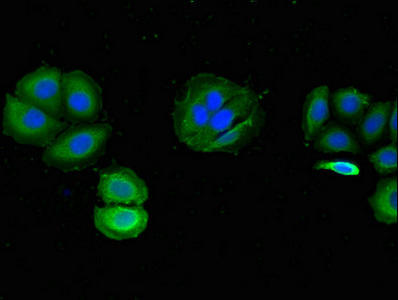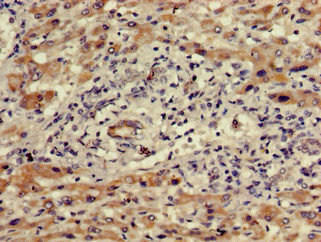Description
| Antibody Name: | WDR19 Antibody (PACO50834) |
| Antibody SKU: | PACO50834 |
| Size: | 50ug |
| Host Species: | Rabbit |
| Tested Applications: | ELISA, IHC, IF |
| Recommended Dilutions: | ELISA:1:2000-1:10000, IHC:1:20-1:200, IF:1:50-1:200 |
| Species Reactivity: | Human |
| Immunogen: | Recombinant Human WD repeat-containing protein 19 protein (45-226AA) |
| Form: | Liquid |
| Storage Buffer: | Preservative: 0.03% Proclin 300 Constituents: 50% Glycerol, 0.01M PBS, pH 7.4 |
| Purification Method: | >95%, Protein G purified |
| Clonality: | Polyclonal |
| Isotype: | IgG |
| Conjugate: | Non-conjugated |
 | Immunohistochemistry of paraffin-embedded human placenta tissue using PACO50834 at dilution of 1:100. |
 | Immunofluorescent analysis of A549 cells using PACO50834 at dilution of 1:100 and Alexa Fluor 488-congugated AffiniPure Goat Anti-Rabbit IgG(H+L). |
 | Immunohistochemistry of paraffin-embedded human liver cancer using PACO50834 at dilution of 1:100. |
| Background: | Component of the IFT complex A (IFT-A), a complex required for retrograde ciliary transport. Involved in cilia function and/or assembly (By similarity). Associates with the BBSome complex to mediate ciliary transport (By similarity). |
| Synonyms: | WD repeat-containing protein 19 (Intraflagellar transport 144 homolog), WDR19, IFT144 KIAA1638 |
| UniProt Protein Function: | |
| UniProt Protein Details: | |
| NCBI Summary: | The protein encoded by this gene is a member of the WD (tryptophan-aspartic acid) repeat family, which is a large family of structurally-related proteins known to participate in a wide range of cellular processes. Each WD repeat typically contains about 40 amino acids that are usually bracketed by glycine-histidine and tryptophan-aspartic acid (WD) dipeptides. This protein contains six WD repeats, three transmembrane domains, and a clathrin heavy-chain repeat. Mutations in this gene have been described in individuals with a wide range of disorders affecting function of the cilium. These disorders are known as ciliopathies, and include Jeune syndrome, Sensenbrenner syndromes, Senior-Loken syndrome, combined or isolated nephronophthisis (NPHP), and retinitis pigmentosa (RP). Alternative splicing results in multiple transcript variants encoding different isoforms. [provided by RefSeq, Dec 2015] |
| UniProt Code: | Q8NEZ3 |
| NCBI GenInfo Identifier: | 21619140 |
| NCBI Gene ID: | 57728 |
| NCBI Accession: | BC032578 |
| UniProt Secondary Accession: | Q8NEZ3,Q8N5B4, Q9H5S0, Q9HCD4, B5MEF2 |
| UniProt Related Accession: | Q8NEZ3 |
| Molecular Weight: | 53,573 Da |
| NCBI Full Name: | Homo sapiens WD repeat domain 19, mRNA |
| NCBI Synonym Full Names: | WD repeat domain 19 |
| NCBI Official Symbol: | WDR19 |
| NCBI Official Synonym Symbols: | ATD5; CED4; DYF-2; ORF26; Oseg6; PWDMP; SRTD5; IFT144; NPHP13 |
| NCBI Protein Information: | WD repeat-containing protein 19 |
| UniProt Protein Name: | |
| UniProt Synonym Protein Names: | |
| Protein Family: | WD repeat-containing protein |
| UniProt Gene Name: | |
| UniProt Entry Name: |






